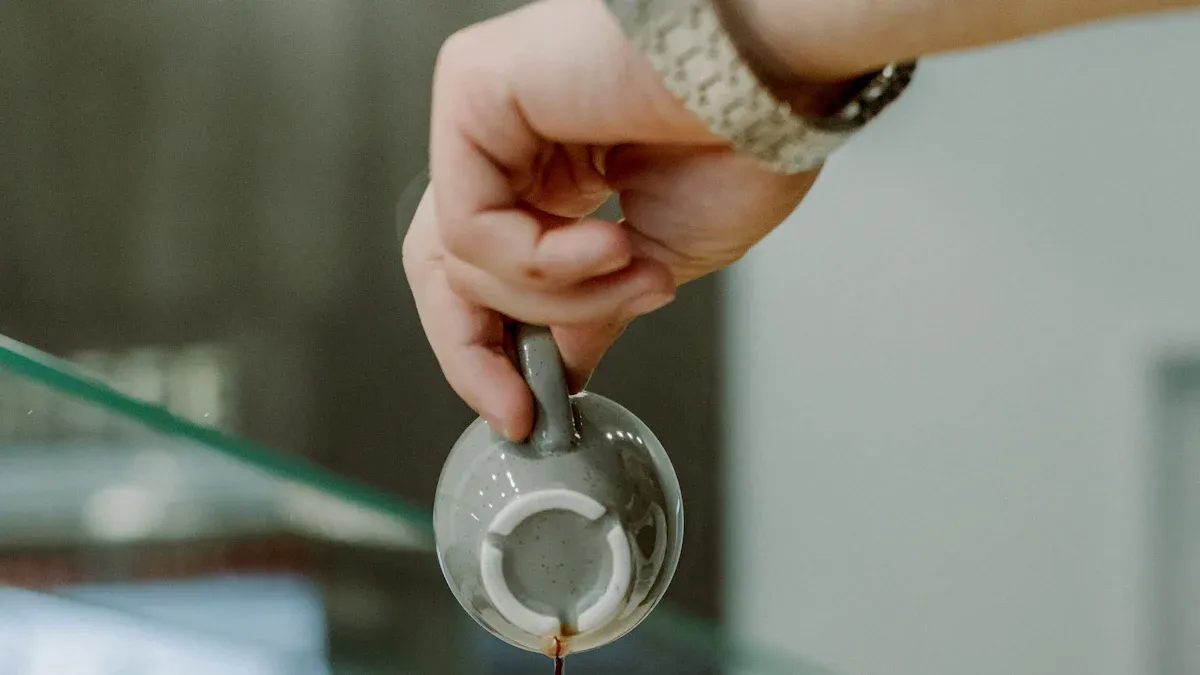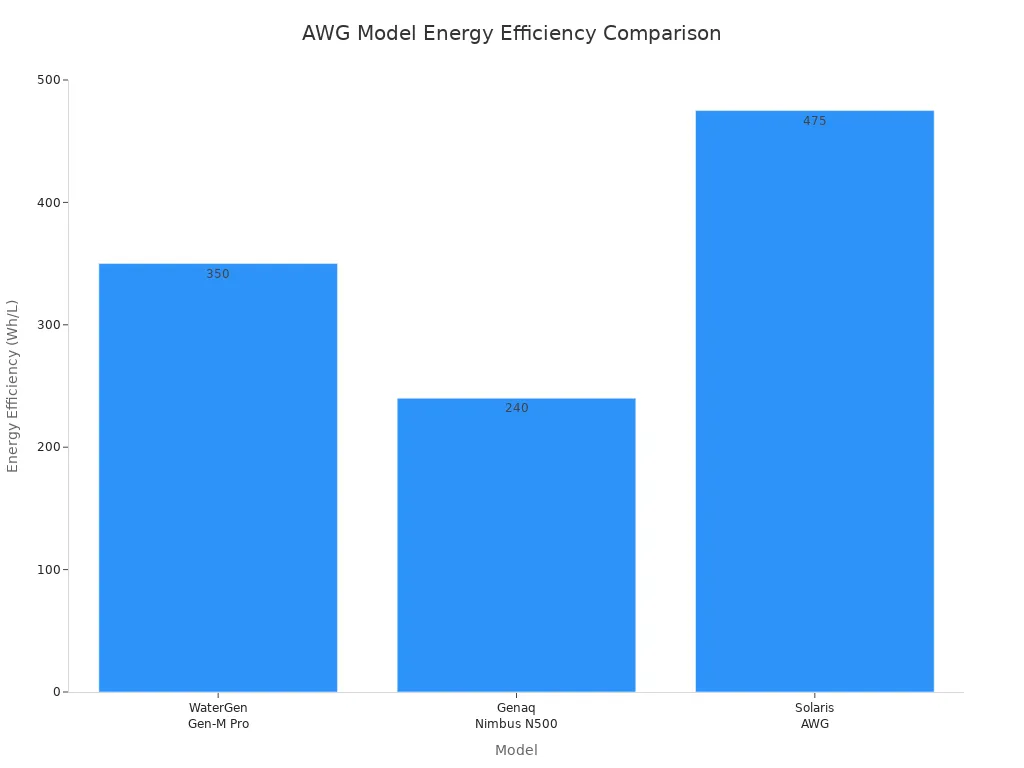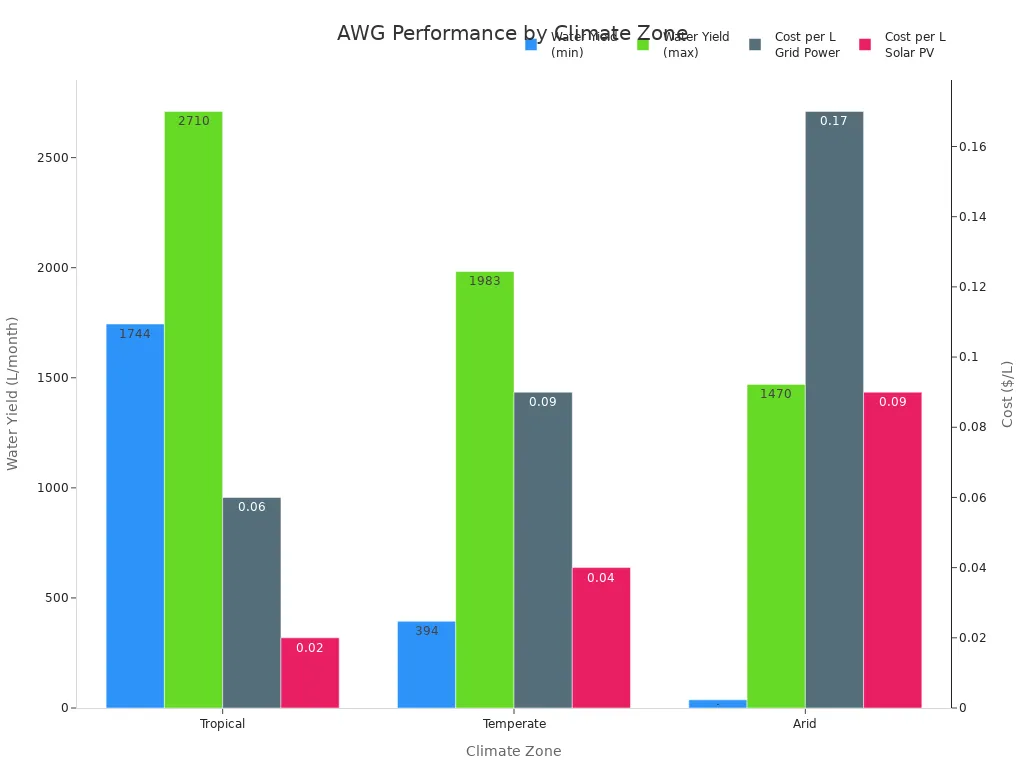You can turn the air around you into clean drinking water with an air water generator. This device pulls moisture from the air, then filters and purifies it so you get safe water to drink. Recent studies show that these machines could provide safe drinking water for about one billion people worldwide. With strong demand and new technology, the market for air water generators continues to grow every year.
Air water generators pull moisture from the air and turn it into clean, safe drinking water using filtration and purification.
Two main methods extract water: condensation works best in humid places, while desiccant systems perform well in dry areas and use less energy.
These machines include multi-stage filters and UV light to remove germs and impurities, ensuring water safety and good taste.
Energy use varies by model and climate; solar-powered generators save money and help the environment but may produce less water.
Air water generators provide reliable water at home, work, and during emergencies, reducing plastic waste and supporting water independence.
Atmospheric water generator for sale is a device that pulls water from the air around you. You can use it to get clean drinking water, even if you do not have access to a regular water supply. The main goal of an air water generator is to make safe water by capturing moisture from the atmosphere and turning it into liquid water. You will find these machines in homes, offices, and even in remote areas where water is hard to find.
You might wonder how an atmospheric water generator manufacturers actually makes water. The process starts when the machine draws in air and filters out dust and pollutants. After cleaning the air, the device uses one of two main methods to extract water: condensation or desiccant-based extraction.
Tip: Condensation works best in humid climates, while desiccant systems perform well even in drier air.
Here is a table showing the main parts and how they work together:
|
Component/Mechanism |
Description |
|---|---|
|
Air Intake & Filtration |
Filters and cleans incoming air to remove dust, pollutants, and impurities, ensuring water quality. |
|
Cooling/Condensation System |
Cools air below the dew point, causing moisture to turn into water droplets. |
|
Water Collection Tank |
Collects the condensed water droplets. |
|
Multi-Stage Filtration & Purification |
Uses UV light and carbon filters to remove viruses, bacteria, and other contaminants. |
|
Mineralization & Storage |
Adds minerals and stores water in a safe tank. |
|
Alternative Hygroscopic Systems |
Uses special materials to absorb and release water from the air. |
|
Hybrid Systems |
Combines different methods for better efficiency. |
Condensation systems cool the air to make water droplets, much like how dew forms on grass. Desiccant-based systems use materials like silica gel or zeolite to absorb water from the air, then release it when heated. Desiccant methods often use less energy and work better in dry places. New designs now use solar power, special gels, and advanced membranes to collect water even when humidity is low.
You can choose the right air water generator based on your local climate and water needs.
You can use an commercial atmospheric water generator to turn humid air into clean water through condensation. This process works by cooling air below its dew point. When the air gets cold enough, water vapor changes into liquid droplets. This is the same principle that makes water form on a cold glass on a hot day. Air water generators use refrigeration technology, much like an air conditioner, to make this happen.
Here is a simple step-by-step guide to how the condensation process works in an air water generator:
The machine pulls in air using a fan and passes it through a filter to remove dust and particles.
The filtered air moves into a cooling chamber. The system cools the air below its dew point, causing water vapor to condense into liquid water.
The condensed water drips into a collection tank.
The water then goes through several purification steps. These often include carbon filters and UV sterilization to remove bacteria and other contaminants.
Some machines add minerals to improve the taste and health benefits of the water.
The clean, mineralized water is stored in a sealed tank, ready for you to drink.
Tip: Condensation-based air water generators work best in places with high humidity. You will get more water when the air is moist.
Some air water generators use special materials called desiccants to pull water from the air. These materials absorb moisture even when the air feels dry. Silica gel and zeolites are the most common desiccants. They can soak up a lot of water compared to their weight. When the desiccant becomes full of water, the machine heats it up to release the moisture, which then gets collected and purified.
Here is a table showing different desiccants and how much water they can absorb:
|
Desiccant Type |
Water Absorption Capacity (relative to weight) |
|---|---|
|
Silica Gel |
Approximately 0.3 times its weight (e.g., 300 g water per 1 kg) |
|
Zeolites (Molecular Sieves) |
Between 0.3 and 4 times their weight depending on conditions |
|
Metal-Organic Frameworks (MOFs) |
Up to 0.4 times their weight under optimal conditions |
|
Hydrogels |
Potentially 10 to 100 times their weight but require salts for direct air moisture capture |
|
Calcium Chloride |
High absorption rate, fast moisture uptake (exact capacity varies) |
|
Activated Alumina |
Commonly used for high humidity, capacity not specified |
|
Clay-based Desiccants |
Lower capacity, used for less rigorous processes |
You will find that desiccant-based air water generators often use less energy than condensation models. They also work well in dry climates where traditional systems struggle. Some advanced systems use metal-organic frameworks or hydrogels to boost water collection, especially when humidity is low.
After the desiccant releases the water, the machine collects it and sends it through filters and UV sterilization. This step removes any harmful substances and makes the water safe to drink. Some systems also add minerals to improve taste and health benefits.
Note: Desiccant-based air water generators can save up to 50% more energy compared to traditional condensation models. They also produce more water in hot and humid climates.
Both condensation and desiccant methods include important steps for filtration, purification, and mineralization. These steps ensure that the water you get from your air water generator is clean, safe, and tastes good.

When you use an air water generator, you want to know the water is safe. These machines use several purification steps to make sure the water you drink is clean and healthy. Most air water generators include a multi-stage filtration system. Here are the main steps you will find:
Activated carbon filters remove odors, chlorine, and many chemicals.You will also see some machines use patented or proprietary filtration systems. These systems help remove a wide range of contaminants, such as sediments, organic and inorganic pollutants, herbicides, pesticides, fertilizers, and disinfectants. Regular maintenance and cleaning are important. This prevents microbial growth and keeps your water fresh.
Tip: Always choose an air water generator with certified filters and a strong purification process. This ensures your water meets global drinking water standards.
You need to trust that your air water generator produces water that is safe to drink. Manufacturers design these machines to meet strict international and national safety standards. Here are some key points:
Air water generators must produce microbiologically safe drinking water.
Certification to standards like IAPMO/ASSE 1090-2020 is required. This covers performance, materials, and filter testing.
The 2021 Uniform Plumbing Code (UPC) mandates compliance with ASSE, IAPMO, and NSF International standards.
AWGs must use safe materials that do not leach contaminants.
Multiple barriers, such as UV disinfection and point-of-use treatment, help prevent airborne contaminants from entering the water.
Manufacturers often use advanced filtration, such as carbon, calcite, and magnesium filters, to meet or exceed water purity requirements. Many companies provide performance data under standard conditions, which helps you trust the quality and safety of your water. These steps ensure your air water generator meets regulations in different countries and keeps your water safe every day.
You need to know how much energy an air water generator uses before you decide to buy one. The amount of electricity needed depends on the model and the weather. On average, these machines use about 2.25 kilowatt-hours (kWh) of electricity to make one liter of water. In perfect conditions, like 22°C and 63% humidity, the energy use can drop to 0.84 kWh per liter. If the air is dry or cold, the machine will use more energy, sometimes over 2.1 kWh per liter.
Some high-efficiency models only need about 50 watts to make a liter of water when the temperature is 25°C and the humidity is 70%. You can power these devices with electricity from the grid, solar panels, or even gas. Solar-powered air water generators are popular in remote areas because they do not need a power line. They also help lower your carbon footprint.
Here is a table comparing different models and their energy use:
|
Model |
Power Source |
Energy Efficiency (Wh/L) |
Price Range |
Notes |
|---|---|---|---|---|
|
WaterGen Gen-M Pro |
Grid-powered |
350 |
> $85,000 |
High capacity, high energy use |
|
Genaq Nimbus N500 |
Solar/off-grid |
240 |
N/A |
Good for off-grid use |
|
Solaris AWG |
Solar/off-grid |
~475 |
~$879 |
Low capacity, low energy use |
|
SOURCE Hydropanel |
Solar/off-grid |
Low water output |
High installation & maintenance cost |
|
Tip: Solar-powered models cost less to run and are better for the environment, but they make less water than grid-powered machines.

The amount of water your air water generator can make depends on the weather. These machines work best when the air is warm and humid. Most models need at least 60% relative humidity and a temperature of about 27°C to work well. In places with 75% humidity, like coastal areas, you will get the most water. If the humidity drops below 40%, the machine may not make any water at all.
Here is a table showing how climate affects water production and cost:
|
Climate Zone |
Water Yield (L/month) |
Cost of Water ($/L) Grid Power |
Cost of Water ($/L) Solar PV |
Seasonal Variability |
Notes |
|---|---|---|---|---|---|
|
Tropical |
1744 – 2710 |
0.06 |
0.02 |
Low |
Best yield, lowest cost |
|
Temperate |
394 – 1983 |
0.09 |
0.04 |
Moderate |
Moderate yield and cost |
|
Arid |
37 – 1470 |
0.17 |
0.09 |
High |
Lowest yield, highest cost |
You will see the highest water output in summer, especially in tropical climates. In arid regions, water production drops and costs go up. Desiccant-based systems can help in dry areas, but condensation-based machines work best where it is warm and humid.

Note: If you live in a dry or cold place, check the humidity before buying an air water generator. You may need a special model for your climate.
You can use an air water generator at home or in your office to get safe drinking water every day. These devices help you reduce your need for bottled water, which means you create less plastic waste. In your home, you give your family a steady supply of pure water. In the office, you provide your team with a healthy option for hydration.
Most home and office models produce about 12 to 16 liters of water each day when the temperature is around 30°C and the humidity is 80%. Some larger systems, like those used in demonstration homes, can make up to 80 gallons (about 303 liters) daily, but these are not typical for regular households or offices.
|
Model |
Daily Water Production (Liters) |
Storage Capacity (Liters) |
Working Conditions (Temp & Humidity) |
|---|---|---|---|
|
16 |
8 |
30℃ & 80% RH |
|
|
HR-90HK (Household Generator) |
~12-13 |
12.5 |
15-40℃ & 35-95% RH |
|
HR-88C (Office Generator) |
Similar scale |
16 |
15-40℃ & 35-95% RH |
Many users say the water tastes better than tap or well water. You also gain more independence because you do not rely on city water or delivery services. Some people enjoy the cost savings and the ability to use solar power for extra convenience.
 online service
online service sale@accairwater.com
sale@accairwater.com +86 18559227773
+86 18559227773